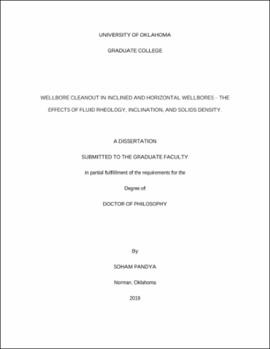| dc.contributor.advisor | Ahmed, Ramadan | |
| dc.contributor.author | Pandya, Soham | |
| dc.date.accessioned | 2019-08-30T18:50:47Z | |
| dc.date.available | 2019-08-30T18:50:47Z | |
| dc.date.issued | 2019-08-30 | |
| dc.identifier.uri | https://hdl.handle.net/11244/321402 | |
| dc.description.abstract | Recent technical improvements in the drilling process have allowed drilling of high inclination and horizontal wells with longer laterals. The frequency of such wells has increased over time due to their advantage of increased contact area with the reservoir. However, the complexity of these wells results in more well completion problems such as deposition of solids in the wellbore and increased Non-Productive Time (NPT). The reduction of NPT depends on factors influencing the mechanism of solids transport. The dominance of gravity over buoyancy forces the solids to settle vertically downwards irrespective of the direction of the flow. However, the distance required for solids to settle downwards is significantly reduced in directional and horizontal wells. Moreover, the fluid flow in these wells has a reduced velocity component in the vertical direction. The substantial reduction of the vertical component of fluid velocity, which prevents solids from settling, results in rapid solids deposition and bed build up. Also, the forces acting on the flow protruding particle of the bed determine the erosion mechanism of solids bed formed in inclined and horizontal wells.
This study undertakes an experimental approach to solve the problem of optimization of wellbore cleanout process in deviated and horizontal well sections. In addition, Computational Fluid Dynamics (CFD) approach is incorporated to interpret and explain experimental observations. Experimental investigations were carried out using a large-scale flow loop. Bed-erosion experiments were conducted in an eccentric annulus (140 mm × 60 mm annular geometry and 10.36 m long section) to study the effects of several influencing factors (fluid rheology, inclination, and solid density) on wellbore cleanout efficiency. The effects of these factors were analyzed in terms of normalized bed erosion curves (reduction of bed height with time) and cleanout efficiency (percentage removal of solids weight).
Experimental results demonstrated that high-viscosity fluids are superior cleanout medium at low inclinations due to their better solids suspension capability while low-viscosity fluids have greater erosion capability and thereby perform well at high inclinations and horizontal configuration. CFD simulations show that low-viscosity fluids have significantly greater local velocity in the vicinity of the bed than highly viscous fluids, even though the viscous fluid exhibit a higher bed shear stress. The analysis indicates that the local fluid velocity is more important than bed shear stress in eroding the bed. Besides this, the density of solids was found to have a moderate effect on the hole cleaning process, and solids with higher density were slightly more difficult to remove from the wellbore section.
Furthermore, experimental results are analyzed by developing a dimensionless relationship between various influential parameters. The correlation developed is capable of upscaling the lab-scale model to field scale. This was validated by comparing the results obtained from the model with those measured by other studies. The maximum error in the prediction of this model is less than 20%. In general, the model can be directly applied in field scenarios with considerable accuracy within the specified ranges of dimensionless groups. | en_US |
| dc.language | en_US | en_US |
| dc.subject | Engineering, Petroleum. | en_US |
| dc.subject | Energy. | en_US |
| dc.subject | Operations Research. | en_US |
| dc.subject | Physics, General. | en_US |
| dc.title | Wellbore Cleanout in Inclined and Horizontal Wellbores – The Effects of Fluid Rheology, Inclination, and Solids Density. | en_US |
| dc.contributor.committeeMember | Shah, Subhash | |
| dc.contributor.committeeMember | Vedula, Prakash | |
| dc.contributor.committeeMember | Teodoriu, Catalin | |
| dc.contributor.committeeMember | Salehi, Saeed | |
| dc.date.manuscript | 2019-08-30 | |
| dc.thesis.degree | Ph.D. | en_US |
| ou.group | Mewbourne College of Earth and Energy::Mewbourne School of Petroleum and Geological Engineering | en_US |
| shareok.orcid | 0000-0001-8577-4731 | en_US |
